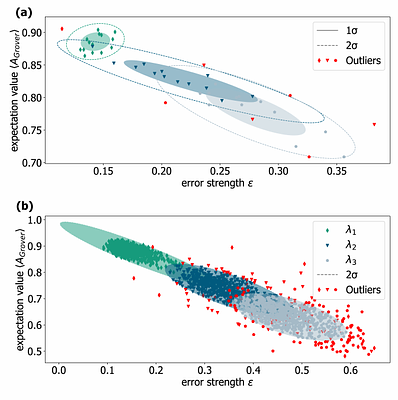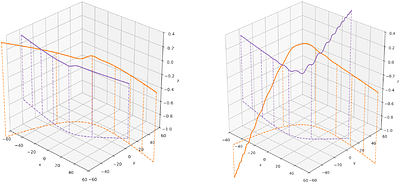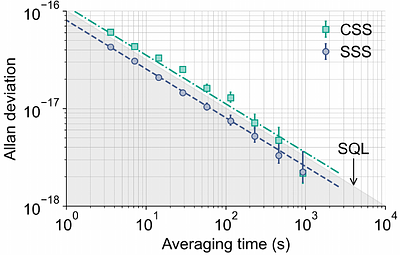Accelerator PhysicsAdaptation and Self-Organizing SystemsApplied PhysicsAtomic, Molecular and Optical PhysicsAtomic PhysicsBiological PhysicsClassical PhysicsCondensed Matter PhysicsDisordered Systems and Neural Networks
By: Chenghong Zhu, Xian Wu, Hao-Kai Zhang, Sixuan Wu, Guangxi Li, Xin Wang
Balancing trainability and expressibility is a central challenge in variational quantum computing, and quantum architecture search (QAS) plays a pivotal role by automatically designing problem-specific parameterized circuits that address this trade-off. In this work, we introduce a scalable, training-free QAS framework that efficiently explores and evaluates quantum circuits through landscape fluctuation analysis. This analysis captures key c... more
Balancing trainability and expressibility is a central challenge in variational quantum computing, and quantum architecture search (QAS) plays a pivotal role by automatically designing problem-specific parameterized circuits that address this trade-off. In this work, we introduce a scalable, training-free QAS framework that efficiently explores and evaluates quantum circuits through landscape fluctuation analysis. This analysis captures key characteristics of the cost function landscape, enabling accurate prediction of circuit learnability without costly training. By combining this metric with a streamlined two-level search strategy, our approach identifies high-performance, large-scale circuits with higher accuracy and fewer gates. We further demonstrate the practicality and scalability of our method, achieving significantly lower classical resource consumption compared to prior work. Notably, our framework attains robust performance on a challenging 50-qubit quantum many-body simulation, highlighting its potential for addressing complex quantum problems. less
By: Dhiman Bhowmick, Vir B. Bulchandani, Wen Wei Ho
Quantum many-body scars are atypical energy eigenstates of chaotic quantum many-body systems that prevent certain special non-equilibrium initial conditions from thermalizing. We point out that quantum many-body scars exist for any nearest-neighbor spin-$S$ XYZ quantum spin chain, and arise in the form of an infinite family of highly excited yet nonentangled product-state eigenstates, which define periodic textures in spin space. This set of ... more
Quantum many-body scars are atypical energy eigenstates of chaotic quantum many-body systems that prevent certain special non-equilibrium initial conditions from thermalizing. We point out that quantum many-body scars exist for any nearest-neighbor spin-$S$ XYZ quantum spin chain, and arise in the form of an infinite family of highly excited yet nonentangled product-state eigenstates, which define periodic textures in spin space. This set of scars, discovered originally by Granovskii and Zhedanov in 1985, encompasses both the experimentally relevant 'spin helices' for XXZ chains and more complicated helix-like states constructed from Jacobi elliptic functions for generic XYZ chains. An appealing feature of Granovskii-Zhedanov scars is that they are well-defined in the semiclassical limit $S \to \infty$, which allows for a systematic and analytical treatment of their dynamical instability to perturbations of the Hamiltonian. Using time-dependent spin-wave theory, we predict that upon perturbing along certain directions in Hamiltonian space, Granovskii-Zhedanov scars exhibit a dramatic asymmetry in their decay: depending on the sign of the perturbation, the decrease of their contrast is either slow and linear, or fast and exponential in time. This asymmetry can be traced to the absence (presence) of imaginarity in the spectrum of the Bogoliubov Hamiltonian governing quantum fluctuations about the scar, which corresponds to the absence (presence) of a non-zero Lyapunov exponent for the limiting classical trajectory. Numerical simulations using matrix product states (MPS) and infinite time-evolving block decimation (iTEBD) confirm that our prediction remains valid even far from the semiclassical limit. Our findings challenge existing theories of how quantum-many body scars relax. less
By: J. François, L. Ravera
We reassess foundational aspects of Metric-Affine Gravity (MAG) in light of the Dressing Field Method, a tool allowing to systematically build gauge-invariant field variables. To get MAG started, one has to deal with the problem of "gauge translations". We first recall that Cartan geometry is the proper mathematical foundation for gauge theories of gravity, and that this problem never arises in that framework, which still allows to clarify th... more
We reassess foundational aspects of Metric-Affine Gravity (MAG) in light of the Dressing Field Method, a tool allowing to systematically build gauge-invariant field variables. To get MAG started, one has to deal with the problem of "gauge translations". We first recall that Cartan geometry is the proper mathematical foundation for gauge theories of gravity, and that this problem never arises in that framework, which still allows to clarify the geometric status of gauge translations. Then, we show how the MAG kinematics is obtained via dressing in a technically streamlined way, which highlights that it reduces to a Cartan-geometric kinematics. less
By: Laura Mančinska, Pieter Spaas, Taro Spirig
In complexity theory, gap-preserving reductions play a crucial role in studying hardness of approximation and in analyzing the relative complexity of multiprover interactive proof systems. In the quantum setting, multiprover interactive proof systems with entangled provers correspond to gapped promise problems for nonlocal games, and the recent result MIP$^*$=RE (Ji et al., arXiv:2001.04383) shows that these are in general undecidable. Howeve... more
In complexity theory, gap-preserving reductions play a crucial role in studying hardness of approximation and in analyzing the relative complexity of multiprover interactive proof systems. In the quantum setting, multiprover interactive proof systems with entangled provers correspond to gapped promise problems for nonlocal games, and the recent result MIP$^*$=RE (Ji et al., arXiv:2001.04383) shows that these are in general undecidable. However, the relative complexity of problems within MIP$^*$ is still not well-understood, as establishing gap-preserving reductions in the quantum setting presents new challenges. In this paper, we introduce a framework to study such reductions and use it to establish MIP$^*$-completeness of the gapped promise problem for the natural class of independent set games. In such a game, the goal is to determine whether a given graph contains an independent set of a specified size. We construct families of independent set games with constant question size for which the gapped promise problem is undecidable. In contrast, the same problem is decidable in polynomial time in the classical setting. To carry out our reduction, we establish a new stability theorem, which could be of independent interest, allowing us to perturb families of almost PVMs to genuine PVMs. less
7 SciCasts by .
By: Francisco S. N. Lobo, Jorde A. A. Ramos, Manuel E. Rodrigues
We construct a static, spherically symmetric black hole (BH) solution embedded within a dark matter (DM) halo, formulated as a non-vacuum extension of the Schwarzschild spacetime. The DM distribution is modeled via an empirical density profile calibrated to observations of the elliptical galaxy NGC 4649 (M60), incorporating Hubble Space Telescope (HST) imaging, stellar velocity dispersion data, and globular cluster dynamics. The resultant spa... more
We construct a static, spherically symmetric black hole (BH) solution embedded within a dark matter (DM) halo, formulated as a non-vacuum extension of the Schwarzschild spacetime. The DM distribution is modeled via an empirical density profile calibrated to observations of the elliptical galaxy NGC 4649 (M60), incorporating Hubble Space Telescope (HST) imaging, stellar velocity dispersion data, and globular cluster dynamics. The resultant spacetime metric depends on three independent parameters: the black hole mass $M$, the asymptotic circular velocity $V_c$, and the halo scale radius $a$, and smoothly reduces to the Schwarzschild limit as $V_c \to 0$ and $a \to 0$. We analyze the influence of the halo on key geometric and physical quantities, including the event horizon radius, photon sphere, shadow size, and curvature invariants. The Kretschmann scalar exhibits an enhanced sensitivity to halo-induced modifications, particularly in the near-horizon regime. Thermodynamic properties of the solution are also examined. In the extremal limit, characterized by a vanishing surface gravity, the model supports a finite tangential pressure, implying a non-trivial extension of standard black hole thermodynamics. These results highlight the relevance of incorporating astrophysical environments into BH modeling and offer new avenues for testing strong-field gravity through precision observational data. less
By: Raymond Isichei, Joao Magueijo
We explore the possibility that part of what we call dark matter may be the mark of a preferred frame, revealing a breakdown of diffeomorphism invariance. In the non-relativistic limit this appears as a deviant matter source capable of attracting normal matter, but not feeling the attraction from other forms of matter or from itself. While this implies a violation of momentum conservation, no logical inconsistencies arise in this deviant ``Ne... more
We explore the possibility that part of what we call dark matter may be the mark of a preferred frame, revealing a breakdown of diffeomorphism invariance. In the non-relativistic limit this appears as a deviant matter source capable of attracting normal matter, but not feeling the attraction from other forms of matter or from itself. While this implies a violation of momentum conservation, no logical inconsistencies arise in this deviant ``Newtonian'' limit. In contrast, due to Bianchi identities, the relativistic theory must undergo core change, and we discuss a modification of Einstein's gravity capable of coupling a non-conserved source to gravity. It results from fixing some of the spatial components of the metric, thereby constraining the possible diffeomorphisms and clipping some of the equations. Bianchi identities can always be used to refill the equations, but the effective Stueckelberg stresses are so outlandish that this defines symmetry breakdown and violations of local energy-momentum conservation. We work out spherically symmetric solutions with static halos and flat rotation curves, with and without a central black hole. The model has the drawback that it can evade experimental constraints simply by setting to zero the local density of deviant matter (which is a non-dynamic input). Its presence, in contrast, would leave inimitable signatures. We briefly discuss the Hamiltonian formulation of these models, where such dark matter appears as a central charge in the Poisson bracket of the Hamiltonian and the momentum. less
By: Kathrin F. Koenig, Finn Reinecke, Thomas Wellens
Coping with noise in quantum computation poses significant challenges due to its unpredictable nature and the complexities of accurate modeling. This paper presents noise-adaptive folding, a technique that enhances zero-noise extrapolation (ZNE) through the use of adaptive scaling factors based on circuit error measurements. Furthermore, we introduce two filtering methods: one relies on measuring error strength, while the other utilizes stati... more
Coping with noise in quantum computation poses significant challenges due to its unpredictable nature and the complexities of accurate modeling. This paper presents noise-adaptive folding, a technique that enhances zero-noise extrapolation (ZNE) through the use of adaptive scaling factors based on circuit error measurements. Furthermore, we introduce two filtering methods: one relies on measuring error strength, while the other utilizes statistical filtering to improve the extrapolation process. Comparing our approach with standard ZNE reveals that adaptive scaling factors can be optimized using either a noise model or direct error strength measurements from inverted circuits. The integration of adaptive scaling with filtering techniques leads to notable improvements in expectation-value extrapolation over standard ZNE. Our findings demonstrate that these adaptive methods effectively strengthen error mitigation against noise fluctuations, thereby enhancing the precision and reliability of quantum computations. less
Nonlinear dynamics in Horndeski gravity: a renormalized approach to effective gravitational coupling
0upvotes
By: Luca Amendola, Carla Bernal, Radouane Gannouji
This paper develops a renormalized perturbation theory framework for nonlinear structure formation in a broad class of modified gravity models that exhibit Vainshtein screening, with a focus on a viable subclass of Horndeski theories. We extend earlier perturbative methods, originally applied to DGP model, to construct a self-consistent treatment that captures both the linear modifications to gravity at large scales and the nonlinear screenin... more
This paper develops a renormalized perturbation theory framework for nonlinear structure formation in a broad class of modified gravity models that exhibit Vainshtein screening, with a focus on a viable subclass of Horndeski theories. We extend earlier perturbative methods, originally applied to DGP model, to construct a self-consistent treatment that captures both the linear modifications to gravity at large scales and the nonlinear screening effects at small scales. In the framework, the response of the gravitational potential to matter density fluctuations is characterized by renormalized propagators, leading to the definition of a nonlinear (or renormalized) effective gravitational constant. The paper details several numerical strategies to compute this renormalized gravitational constant. Numerical examples illustrate how the effective gravitational constant evolves with scale and redshift. These results are key to accurately predicting cosmological observables such as the matter power spectrum and bispectrum in modified gravity scenarios. less
By: Marco Calzá, Massimiliano Rinaldi, Sergio Zerbini
Regular and spherically symmetric black holes that solve the singularity problems of the Schwarzschild solution are phenomenologically viable at large distance but usually suffer from the Cauchy horizon instability. To overcome this drawback, we extended the analysis to include hyperbolic and toroidal horizon topologies within the framework of static, topologically maximally symmetric spacetimes. We show that both hyperbolic and toroidal blac... more
Regular and spherically symmetric black holes that solve the singularity problems of the Schwarzschild solution are phenomenologically viable at large distance but usually suffer from the Cauchy horizon instability. To overcome this drawback, we extended the analysis to include hyperbolic and toroidal horizon topologies within the framework of static, topologically maximally symmetric spacetimes. We show that both hyperbolic and toroidal black holes can be constructed without Cauchy horizons and without curvature singularities, thereby avoiding the mass inflation instability. These solutions exhibit asymptotic flatness in a generalized quasi-Minkowskian sense. The phenomenological aspects of these solutions are also studied by examining their thermodynamical properties, the photon sphere, and the effective potentials, ensuring consistency with observable properties such as black hole shadows. Lastly, we investigate a reconstruction technique within a scalar-tensor gravity framework, illustrating how the discussed metrics can arise from well-defined scalar field dynamics. Our investigation presents a viable pathway for constructing physically realistic, regular black holes in both General Relativity and modified gravity, broadening the landscape of singularity-free spacetimes and offering models that may better reflect the nature of strong gravitational fields in astrophysical and cosmological settings. less
By: Takuya Takahashi, Hayato Motohashi, Kazufumi Takahashi
Black hole quasinormal modes (QNMs) can exhibit resonant excitations associated with avoided crossings in their complex frequency spectrum. Such resonance phenomena can serve as novel signatures for probing new physics, where additional degrees of freedom are commonly introduced. Motivated by this possibility, we investigate QNMs in systems where multiple degrees of freedom are coupled with each other, and introduce a definition of excitation... more
Black hole quasinormal modes (QNMs) can exhibit resonant excitations associated with avoided crossings in their complex frequency spectrum. Such resonance phenomena can serve as novel signatures for probing new physics, where additional degrees of freedom are commonly introduced. Motivated by this possibility, we investigate QNMs in systems where multiple degrees of freedom are coupled with each other, and introduce a definition of excitation factors suitable for such systems. To demonstrate our formulation, we apply it to a black hole in the Einstein-Maxwell-axion theory, where we find that avoided crossings can appear even between longest-lived modes originating from the fundamental modes of different degrees of freedom, in contrast to the Kerr case in General Relativity. We show that the excitation factors are indeed amplified as a manifestation of resonance at parameter values corresponding to the avoided crossings. less
By: Hanno Sahlmann, Waleed Sherif
Spinfoam theories propose a well-defined path-integral formulation for quantum gravity and are hoped to provide the dynamics of loop quantum gravity. However, it is computationally hard to calculate spinfoam amplitudes. The well-studied Euclidean Barrett-Crane model provides an excellent setting for testing analytical and numerical tools to probe spinfoam models. We explore a data-driven approach to accelerating spinfoam computations by showi... more
Spinfoam theories propose a well-defined path-integral formulation for quantum gravity and are hoped to provide the dynamics of loop quantum gravity. However, it is computationally hard to calculate spinfoam amplitudes. The well-studied Euclidean Barrett-Crane model provides an excellent setting for testing analytical and numerical tools to probe spinfoam models. We explore a data-driven approach to accelerating spinfoam computations by showing that the vertex amplitude is an object that can be learned from data using deep learning. We divide the learning process into a classification and a regression task: Two networks are independently engineered to decide whether the amplitude is zero or not and to predict the precise numerical value, respectively. The trained networks are tested with several accuracy measures. The classifier in particular demonstrates robust generalisation far outside the training domain, while the regressor demonstrates high predictive accuracy in the domain it is trained on. We discuss limitations, possible improvements, and implications for future work. less
By: Brian Kent, Aaron Zimmerman
The double copy relates gauge and gravitational theories, with widespread application to quantum scattering amplitudes and classical perturbative results. It also connects exact classical solutions of abelian gauge and gravitational theories in a small number of specific examples, known as classical double copies. These have a number of special properties, such as being algebraically special. It remains an open question if classical doubles c... more
The double copy relates gauge and gravitational theories, with widespread application to quantum scattering amplitudes and classical perturbative results. It also connects exact classical solutions of abelian gauge and gravitational theories in a small number of specific examples, known as classical double copies. These have a number of special properties, such as being algebraically special. It remains an open question if classical doubles copies exist for algebraically general spacetimes, or those which possess nontrivial dynamics. Here we provide a novel framework for understanding classical double copies at the level of the metric, both organizing the known examples and exploring their properties under a new lens. Utilizing Killing vectors as natural gauge fields on a spacetime, we propose a procedure for generating new classical double copies. As a proof of concept, we provide a flat space single copy for the Kasner metric, an algebraically general spacetime. This example is also a double copy at the level of its curvature, and provides the first type I Weyl double copy, confirming expectations from perturbation theory. This provides a promising avenue for extending exact double copies to a broader class of general, physically relevant spacetimes. less
By: Felix M. Heinze, Bernd Brügmann, Tim Dietrich, Ivan Markin
In this proof-of-principle study, we demonstrate the capability of the numerical-relativity code BAM to simulate fully relativistic black-hole binary-single and binary-binary encounters that result in flybys, delayed or accelerated eccentric mergers, exchanges, and other more complex dynamical interactions of initially non-spinning, equal-mass black holes. Our results show that we are able to simulate the time evolution of $N$ black holes in ... more
In this proof-of-principle study, we demonstrate the capability of the numerical-relativity code BAM to simulate fully relativistic black-hole binary-single and binary-binary encounters that result in flybys, delayed or accelerated eccentric mergers, exchanges, and other more complex dynamical interactions of initially non-spinning, equal-mass black holes. Our results show that we are able to simulate the time evolution of $N$ black holes in relativistic scattering scenarios, which exhibit interesting dynamics and gravitational-wave signals. The dynamics of these systems show noticeable differences compared to analogous systems in post-Newtonian approximations up to 2.5PN. A key result is that the gravitational waveforms exhibit remarkable features that could potentially make them distinguishable from regular binary mergers. less
By: Y. A. Yang, Maya Miklos, Yee Ming Tso, Stella Kraus, Joonseok Hur, Jun Ye
Optical atomic clocks with unrivaled precision and accuracy have advanced the frontier of precision measurement science and opened new avenues for exploring fundamental physics. A fundamental limitation on clock precision is the Standard Quantum Limit (SQL), which stems from the uncorrelated projection noise of each atom. State-of-the-art optical lattice clocks interrogate large ensembles to minimize the SQL, but density-dependent frequency s... more
Optical atomic clocks with unrivaled precision and accuracy have advanced the frontier of precision measurement science and opened new avenues for exploring fundamental physics. A fundamental limitation on clock precision is the Standard Quantum Limit (SQL), which stems from the uncorrelated projection noise of each atom. State-of-the-art optical lattice clocks interrogate large ensembles to minimize the SQL, but density-dependent frequency shifts pose challenges to scaling the atom number. The SQL can be surpassed, however, by leveraging entanglement, though it remains an open problem to achieve quantum advantage from spin squeezing at state-of-the-art stability levels. Here we demonstrate clock performance beyond the SQL, achieving a fractional frequency precision of 1.1 $\times 10^{-18}$ for a single spin-squeezed clock. With cavity-based quantum nondemolition (QND) measurements, we prepare two spin-squeezed ensembles of $\sim$30,000 strontium atoms confined in a two-dimensional optical lattice. A synchronous clock comparison with an interrogation time of 61 ms achieves a metrological improvement of 2.0(2) dB beyond the SQL, after correcting for state preparation and measurement errors. These results establish the most precise entanglement-enhanced clock to date and offer a powerful platform for exploring the interplay of gravity and quantum entanglement. less













